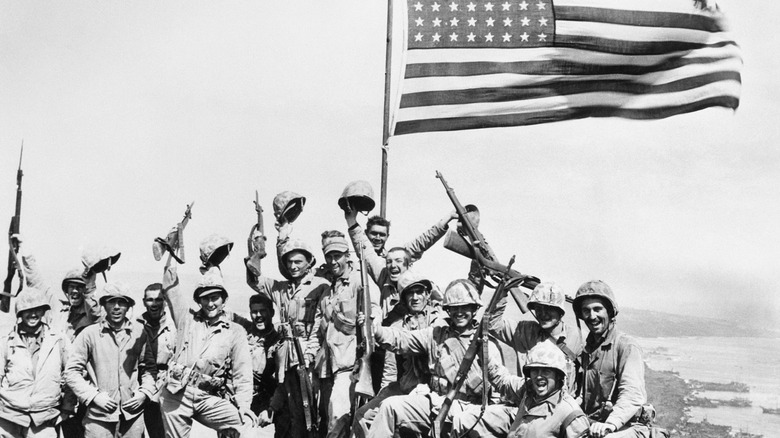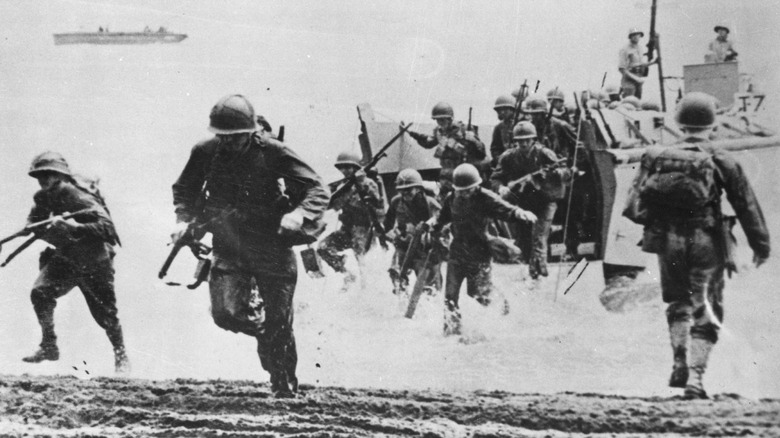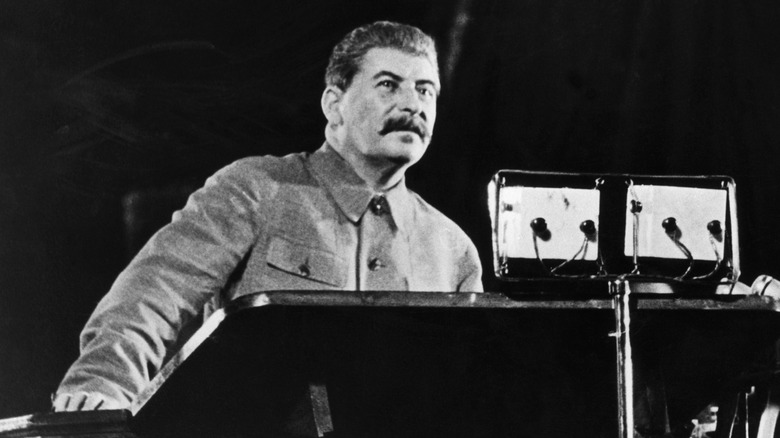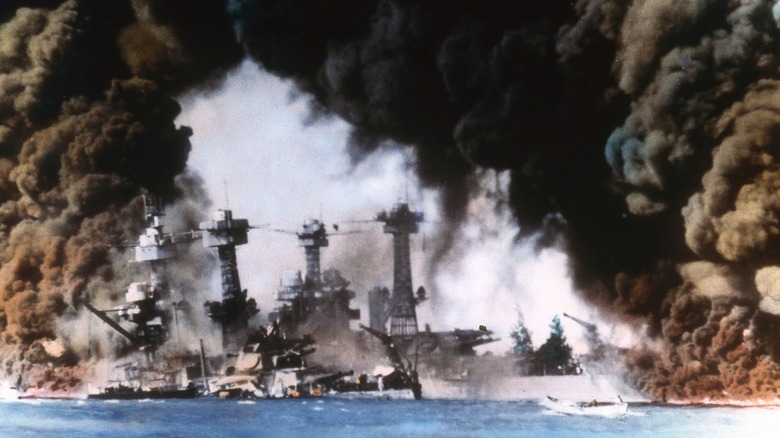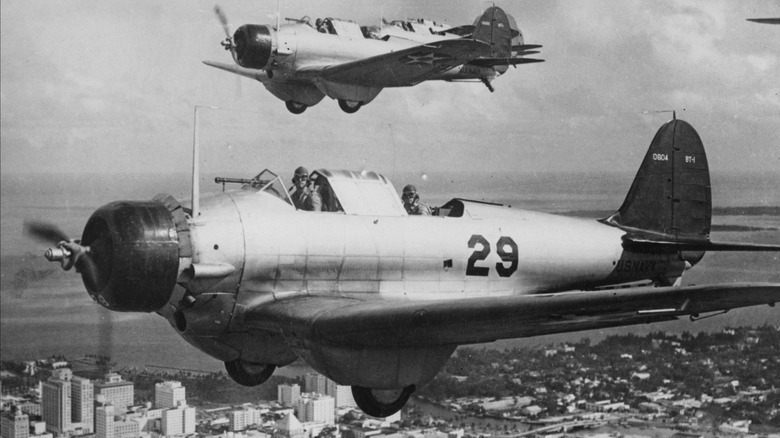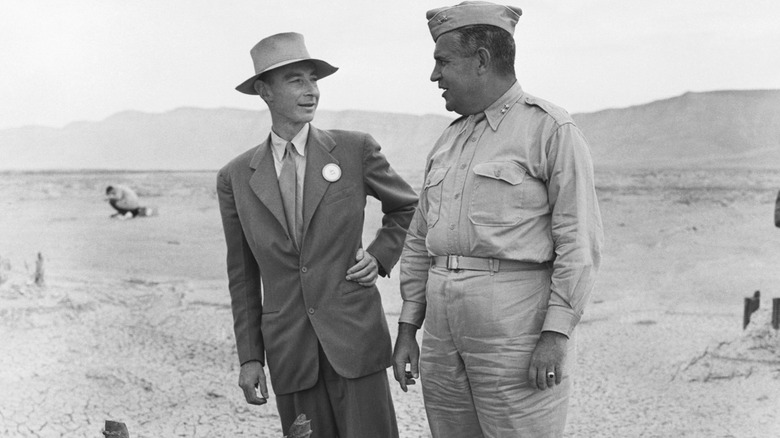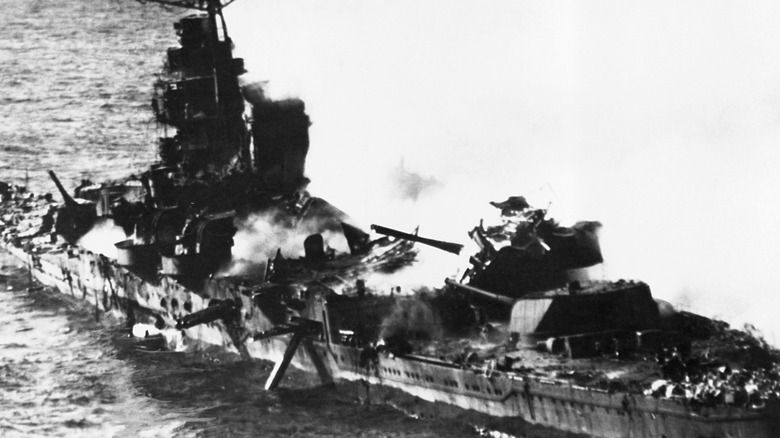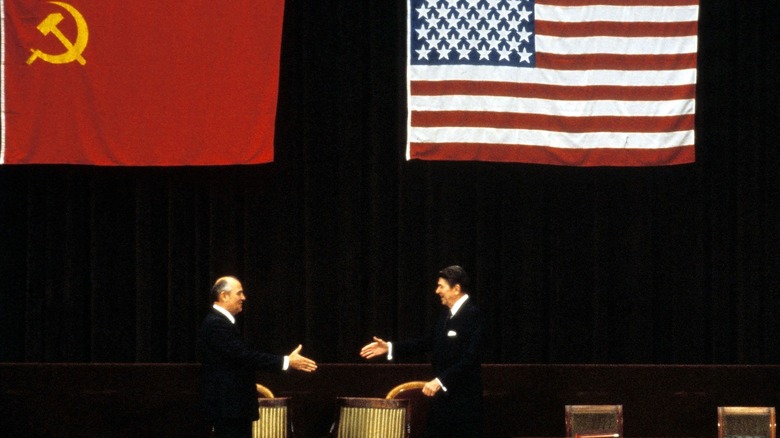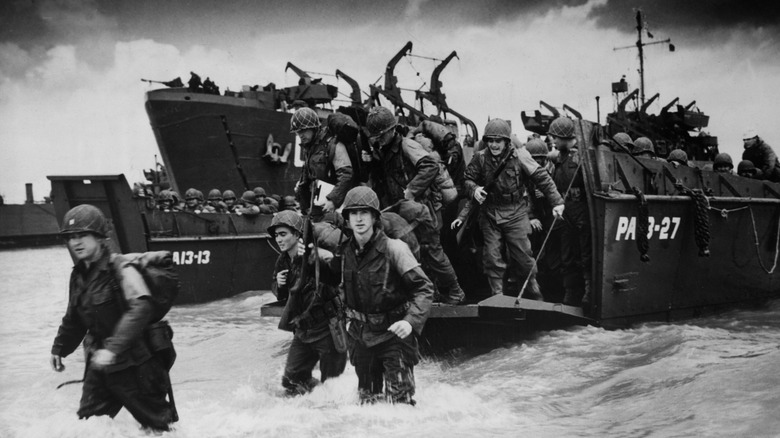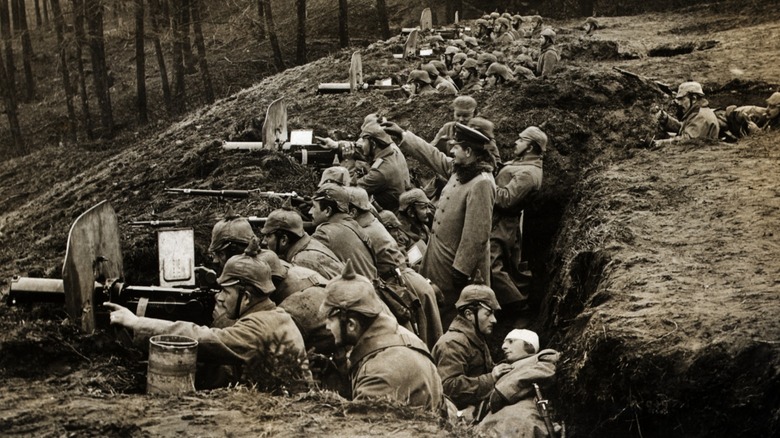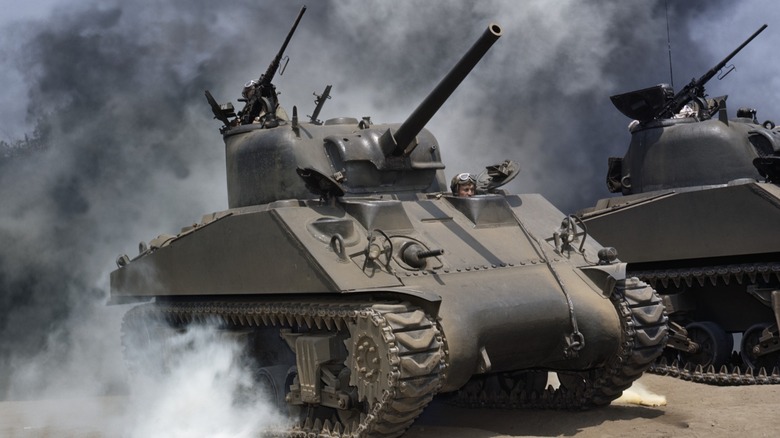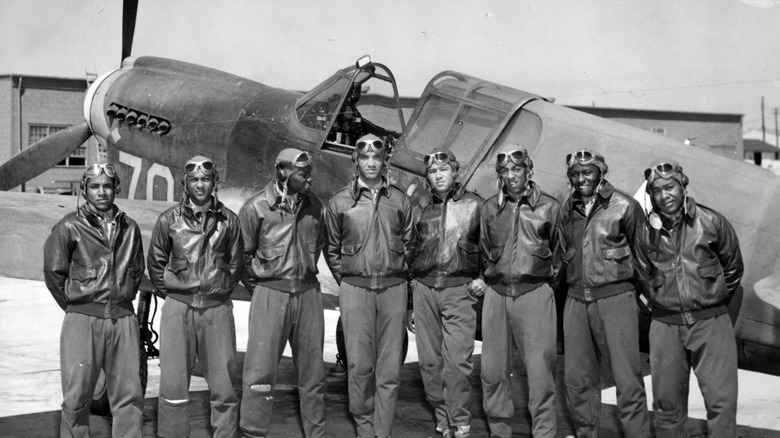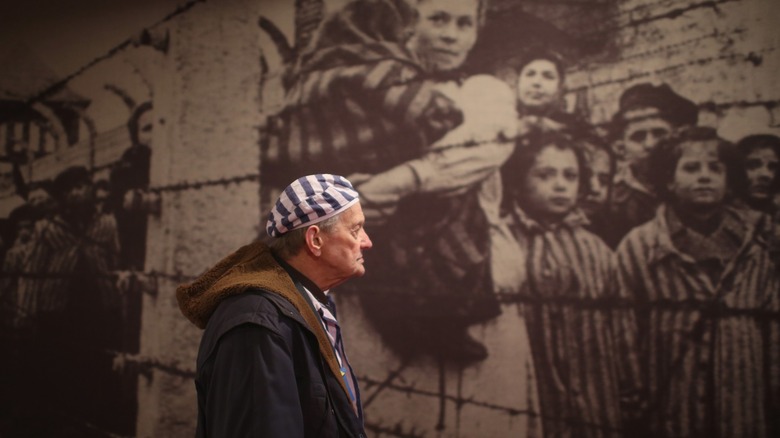Why World War II Is Discussed More Than World War I
Without a doubt, two of the most cataclysmic and consequential events of the 20th century were World War I and II. The First World War lasted from 1914–1918, and saw the Allied Powers of the United States, Britain, Russia, France, Japan, and Italy, take on the Central Powers of Germany, Austria-Hungary, and the Ottoman Empire. It's estimated that more than 8.5 million soldiers were killed in the war, and more than 21 million were wounded. It was a level of destruction almost unfathomable at the time.
It was supposed to be "the war to end all wars," but two decades later Europe once again became a massive battlefield. The Allied Powers, now made up of the United States, France, Britain, China, and the Soviet Union, took on the Axis Powers of Nazi Germany, Italy, and Japan. The Second World War went on from 1939-1945 and was far more destructive in terms of human slaughter. Historians estimate anywhere from 35–60 million died during the fighting, and it was one of the most devastating events in human history.
Today, both wars still capture the interest of scholars and history buffs around the world. Yet, for whatever reason, it often seems like World War II gets more attention than World War I in many circles. Here are some of the biggest reasons why.
America was barely in World War I
At least from an American perspective, it's easy to see why World War II often garners more attention and inquiry than World War I: The United States was involved longer, distributed more aid, and fought more battles. Though World War I started in August 1914, the U.S. did not declare war until April 1917, barely 19 months before it would eventually end. On the other hand, the U.S. was involved in World War II much earlier, and ended up participating for three and a half years — more than double the amount of time they were in the first war.
Economically, the U.S. role in World War I amounted to a hefty $7 billion. However, that pales in comparison to the roughly $50 billion the United States gave out in lend-lease supplies alone during World War II. In addition, the postwar Marshall Plan, enacted in 1948 as the European Recovery Program, was massive for the rebuilding of Europe, and is also closely linked to World War II.
Finally, the American role on the battlefield was much more significant in the Second World War. The American Expeditionary Forces' first major contributions didn't occur until very late in World War I, about six months before it ended. In contrast, the U.S. was the primary driver of the Pacific Campaign, and roughly 16 million Americans served in World War II versus 4.7 million in World War I. It's safe to say the expanded U.S. role in World War II has gotten much more attention, and thus discussion.
World War II had more infamous villains
It's a bit strange to think about, but World War II definitely had the more infamous villains versus World War I. During the First World War, the leaders of the Central Powers were Kaiser Wilhelm II of Germany, Emperor Franz Joseph I of Austria-Hungary (followed by his grandnephew, Charles I), and the Young Turk triumvirate of the Ottoman Empire. While these leaders all have their obvious faults, they don't nearly have the same name recognition today compared to the villains of World War II.
In World War II on the Axis side alone, Adolf Hitler, Benito Mussolini, and Emperor Hirohito are all extremely controversial figures. Hitler is by far one of the worst criminals in human history, and he is widely used as a measuring stick for pure evil. His junior partner Benito Mussolini is also notorious for his brutal dictatorship, and the Japanese Emperor Hirohito has an ugly but disputed legacy of conduct during the war.
Even the Allies had their own now-notorious leaders during the war. Joseph Stalin led the Soviet Union, and he is another one of the biggest violators of human rights in history. The future People's Republic of China's leader Mao Zedong was also active during the war as part of the Chinese United Front, and he is considered responsible for more deaths than even Stalin. The other leader of China, Chiang Kai-Shek, is also infamous for his extremely repressive postwar government in Taiwan, which was responsible for countless civilian deaths. Quite the motley collection of "Allies."
Pearl Harbor
The Japanese attack on Pearl Harbor was one of the most tragic incidents in United States history, and it might be the single biggest reason Americans talk about the Second World War more than the First. It commenced in the early hours of December 7, 1941, and was a surprise attack by the Japanese military against the U.S. Navy's base at Pearl Harbor in Oahu, Hawaii.
In all, more than 2,400 Americans lost their lives, including 68 civilians. Several battleships were lost, including the USS Arizona and USS Oklahoma which, combined, accounted for more than 1,400 deaths alone. Every year the nation holds various remembrances on December 7, and the government designated it as the National Pearl Harbor Remembrance Day.
There was no equivalent attack on United States soil during the First World War, and the most comparable incident was probably the sinking of the Lusitania in 1915, which resulted in the deaths of 128 Americans. However, the Lusitania did not cause an immediate declaration of war like Pearl Harbor, and the loss of life was much less. They were both horrible, but Pearl Harbor stands in a category all its own in the American psyche.
The dogfights and fighter pilots of World War II
By far, one of the most intriguing aspects of the Second World War is the role of fighter pilots. Dogfights and bombing runs played significant parts in the fighting above Europe and the Pacific, and today they are some of the most celebrated aspects of the war. Many of the Hollywood movies about World War II, such as "The Tuskegee Airmen" and "Red Tails," largely revolve around the air war that happened hundreds of feet above the ground.
Airplanes also played a role in World War I, but they were not nearly as important as they would become a few decades later. Many of the aircraft of World War I were primitive compared with those of the 1940s, and at first most of them did not even have guns installed on them. The pilots instead relied on handheld weapons to shoot at each other, though machine guns were quickly put in and technology rapidly improved.
One of the biggest battles of World War II, the Battle of Britain, was fought largely through the air and was won by the skilled fighters of the British Royal Air Force (RAF). In addition, the Japanese kamikaze pilots have their own intriguing story, which has attracted lots of attention over the years. The air war of World War II is one of the biggest reasons people continue to talk about it, and it contributed much more to the outcome than its counterpart in World War I.
The atomic bomb
Even today, decades later, the dropping of the atomic bombs to end World War II still brings up strong emotions. These were the first-ever uses of atomic weapons for human destruction, and they heralded an age of nuclear warfare that has still not ended. It's thought that around 120,000 Japanese people died between the twin bombings, the vast majority of them civilians.
Obviously, there were no atomic weapons or bombs used in World War I, because the technology had not been invented yet. The Manhattan Project didn't begin until 1940, and the idea of an atomic bomb wasn't even practical during the 1910s. The legacy of nuclear war is solely connected with World War II, and is a huge reason we still discuss the war today. Not only do the Fat Man and Little Boy atomic bombings have their own legacy, but they spawned the nuclear age we still live in today.
Any responsible discussion of nuclear weapons always goes back to their development and first use, which are both intimately connected with World War II. It's not a happy legacy, but it's one of the most significant of the war. From a media perspective, the atomic bombings have spawned huge Hollywood blockbusters. Most recently, of course, is "Oppenheimer," a biopic about the father of the atomic bomb and his work during the war: J. Robert Oppenheimer (pictured, left).
The naval warfare
Another of the most momentous changes from World War I to World War II was the expansion of the naval war. While the German U-boat submarines of World War I certainly have a fierce and well-earned reputation for brutal efficiency, actual naval combat was much less prevalent and important than in World War II. The majority of the fighting during the First World War took place on land, in contrast to the Second World War, when the Pacific Theater was fought heavily with the use of battleships and carriers.
In terms of major World War I naval battles, there is really only the Battles of Dogger Bank and Jutland. These were big battles that played large roles in the war, but they don't really compare to the massive naval confrontations of World War II. Some of the most important battles of the Second World War, like Midway, Santa Cruz, and Coral Sea, were naval engagements of absolutely epic proportions.
Much of this had to do with the creation and use of the aircraft carrier, which allowed for fighter pilots and bombers to attack places that were previously well outside of their range. This massively intensified and amplified the naval war to untold levels, and has led to much popular and scholarly inquiry. The naval warfare of World War I was still important, but not nearly as attention-grabbing as that of World War II.
It began the Cold War
Besides the incredible destruction stemming from the war itself, one of the big legacies of World War II was the subsequent Cold War that it spawned. The Cold War dominated international politics from the 1940s to the early 1990s, and was a direct result of the political ramifications of the end of the Second World War. The main adversaries in the Cold War were the Eastern Bloc nations, largely under the direction of the communist Soviet Union, and the Western Bloc nations, associated with democracy and the United States.
The Soviet Union was allied with the United States in World War II, but the two were political opposites. The Soviet Union embraced communism and authoritarian rule, while the United States pursued capitalism and democracy. They came together to fight against Nazi Germany, but it was obvious to anyone toward the end of World War II that the postwar period would not be nearly as friendly.
The military victories on the battlefield during the war ended up turning into political victories postwar. The Soviets took over much of Eastern Europe and allied with newly communist China, while the United States formed alliances with Western democracies. The Cold War really started with World War II, and it's pretty much impossible to talk about it without mentioning its origins in the war.
D-Day
Operation Overlord — as it's more commonly known, D-Day — was a massive Allied amphibious invasion during World War II. Today, it sits alongside other famous battles like Yorktown and Gettysburg, as one of the most iconic and important military engagements in United States history. D-Day occurred on June 6, 1944, and was one of the turning points of the war, eventually contributing to the end of the fighting in Europe a year later.
It's undoubtedly true that D-Day played a large part in Allied victory, which is one of the biggest reasons it is so studied and talked about today. There were no comparable amphibious invasions during World War I (or in all of history, for that matter), making D-Day a unique event. More than 150,000 soldiers landed at Normandy on June 6 alone, and thousands of airborne troops parachuted behind enemy lines. Without D-Day, who knows when World War II would have ended, but it almost certainly would have taken longer and cost thousands more lives than it already had.
Additionally, not only is D-Day incredibly important within American history, but Europeans also celebrate it annually. Veterans who participated and civilians who were alive at the time pay their respects every year at the site of the invasion in Normandy. It's truly one of the most important battles in modern world history, and is a big reason we still talk about World War II all the time.
The ever-changing battlefield
In many ways, World War II was a more dynamic war than World War I. During World War I, the Western Front battlefield lines remained almost completely unchanged. For more than three years from late 1914 to early 1918, the front barely shifted more than a few miles at a time, and never more than 50 miles in either direction. The Eastern Front featured much more changing lines and even higher casualties, but the Russian Empire collapsed before the war was over, and it was almost all fought on land.
In contrast, World War II featured much more dynamic fighting on both the Western and Eastern Fronts, and there was also the fighting in the Pacific and Northern Africa, not to mention the expanded air and naval war. The front lines on the Western Front were constantly evolving, especially after the Allied landings at Italy and Normandy, and the Eastern Front also saw various offensives from both sides that saw territory continuously change hands.
There was a Pacific Theater of World War I, but it doesn't really compare with the highly studied island-hopping campaign and naval battles of World War II. Often, histories about World War I focus on its senseless slaughter and massive body counts, while World War II books tend to favor discussions of tactics and the evolution of fighting during the war. World War II was unquestionably the more fluid and dynamic war, and thus receives a bit more attention.
The expanded role of tanks
If you were to look at Hollywood's portrayal of tanks during World War I, you would come away with a pretty distorted view of their effectiveness. While they are often shown as being revolutionary weapons that helped the Allies win the war, the reality is a little bit different. It is true that tanks first came in vogue during World War I, but they were hardly the breakthrough weapon they were intended to be.
The tanks of World War I were primitive, prone to mechanical failure, had dreadful mobility, and didn't really contribute as much as was hoped on the battlefield. That's definitely not the case for World War II, when tanks played a huge role for the armies of both sides. Just looking at it statistically, there were only a few thousand tanks in all of World War I, but more than 50,000 M4 Sherman tanks alone in World War II.
Interwar improvements turned the tank from a liability into an asset, and it found a lot of success on the battlefield. The use of tanks made the close battles in World War II much more deadly and dynamic, and they added a new layer to the combat. Some were even equipped with flamethrowers by the end. It's no surprise historians have focused so much attention on tanks in World War II, and they have always generated a high level of interest in the war.
The legacy left by minority groups and women
One of the richest legacies of World War II is the contributions made by minority groups and women. Sadly, during both world wars the U.S. government heavily discriminated against minority groups. Of the 380,000 African Americans who served in the U.S. Army during the First World War, only 100,000 were allowed in combat. It's thought that around 200,000 Hispanics were deployed in World War I, but largely in non-combat roles, and women's jobs were also limited to just a few positions in the Navy and as nurses.
However, during World War II, minority groups and women's roles were expanded and ended up being one of the deciding factors in the Allied victory. More than one million Black troops served during World War II, including the famed "Tuskegee Airmen," the "Black Panthers" tank battalion, and the all-female "Six-Triple-Eights" postal battalion. Roughly twice the number of Hispanic troops served in World War II than World War I, and there were also the famous American Indian "Code Talkers" who proved instrumental in both theaters of the war. Then there is the "Purple Heart Battalion," which was made up of Japanese-Americans and played an important and critical role in Europe.
Women also played a larger role in World War II, due to the creation of the Women's Army Auxiliary Corps (WAAC) early in 1941. It's hard to overstate how valuable these groups were to Allied efforts in the Second World War, and it's no wonder their contributions have generated so much attention.
The Holocaust
Of all the disastrous parts of the Second World War, one of the most haunting legacies is that of the Holocaust. The Holocaust began in 1933 and predates the fighting in Europe by a few years, but is regarded as one of the central aspects of the war. The Nazis systematically murdered around six million Jewish people, as well as millions of Soviets, Roma, Jehovah's Witnesses, LGBTQ, and other innocent civilians.
The only comparable aspect of World War I would be the Armenian Genocide, which claimed the lives of about 1.5 million Armenians but has received relatively little international attention. Much of this has to do with the Turkish government, which refuses to acknowledge official responsibility over the incident even today and does not participate in commemorations.
In contrast, Germany openly admits and has been transparent regarding the Nazis' responsibility for the atrocities of the Holocaust, and thus there are many monuments memorializing its victims throughout Germany, Europe, and the rest of the world. The Holocaust has been the subject of incredible amounts of research, and it still gets brought up today with sometimes frightening frequency. It is a very tragic and unhappy legacy, but it is an important one nonetheless.
